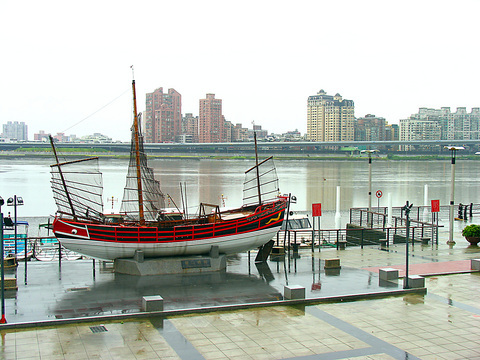Couples picnic on blankets beside the promenade. Children ride bicycles, daring to take off the training wheels. Shutterbugs snap as the sun sinks. These are all scenes to be seen at Taipei City's Dadaocheng Wharf (大稻埕碼頭). And what makes them special is that they weren't here a year ago.
In the past year, the Taipei City Government has spent a considerable sum of money to revitalize not only this wharf, but much of Datong district (大同區) in which it sits.
Chen Feng-yang (陳鳳揚), the neighborhood chief responsible for area, says the amount of money the government has spent is "in the hundreds of millions," but that it's a small price to pay to bring people back to one of Taipei's most historic districts.

PHOTO, DAVID MOMPHARD, TAIPEI TIMES
"It's especially nice to see young people coming here and couples bringing their children," he said. "Datong district's residents are mostly elderly people. They remember when this neighborhood was the heart of Taipei. Creating this riverside park is a good first step, but there is still a lot that needs to be done to make Datong District the place it once was." Among the renovations at Dadaocheng Wharf are a paved promenade along the Tamshui River (淡水河) and a bicycle path through the area that connects with another along the Keelung River (基隆河) and beyond. During weekends, bicycles can be rented at Dadaocheng. Also on weekends, a concessions stand is open for business and refreshments can be enjoyed at one of the umbrella-topped tables on the new veranda.
The harbor is also one of the major points of entry and exit along the recently opened Blue Highway tours of Taipei's rivers. Passengers can board at Dadaocheng and ply the river to Danshui for dinner.
The view from Dadaocheng is acceptable too. Taipei Bridge can be seen to the north and visitors learn from a plaque that it was built in 1925 to replace the original wooden railroad bridge first built in 1893, before being rebuilt again in 1966 and 1991.
Another plaque tells of how Dadaocheng and Datong district became one of Taiwan's most thriving areas around 1869 for the tea trade that flourished here.
"Several of those tea companies are still doing business here," Chen said. "But we look forward to when Datong district flourishes again."

Beijing’s ironic, abusive tantrums aimed at Japan since Japanese Prime Minister Sanae Takaichi publicly stated that a Taiwan contingency would be an existential crisis for Japan, have revealed for all the world to see that the People’s Republic of China (PRC) lusts after Okinawa. We all owe Takaichi a debt of thanks for getting the PRC to make that public. The PRC and its netizens, taking their cue from the Chinese Communist Party (CCP), are presenting Okinawa by mirroring the claims about Taiwan. Official PRC propaganda organs began to wax lyrical about Okinawa’s “unsettled status” beginning last month. A Global

Taiwan’s democracy is at risk. Be very alarmed. This is not a drill. The current constitutional crisis progressed slowly, then suddenly. Political tensions, partisan hostility and emotions are all running high right when cool heads and calm negotiation are most needed. Oxford defines brinkmanship as: “The art or practice of pursuing a dangerous policy to the limits of safety before stopping, especially in politics.” It says the term comes from a quote from a 1956 Cold War interview with then-American Secretary of State John Foster Dulles, when he said: ‘The ability to get to the verge without getting into the war is

Dec. 22 to Dec. 28 About 200 years ago, a Taoist statue drifted down the Guizikeng River (貴子坑) and was retrieved by a resident of the Indigenous settlement of Kipatauw. Decades later, in the late 1800s, it’s said that a descendant of the original caretaker suddenly entered into a trance and identified the statue as a Wangye (Royal Lord) deity surnamed Chi (池府王爺). Lord Chi is widely revered across Taiwan for his healing powers, and following this revelation, some members of the Pan (潘) family began worshipping the deity. The century that followed was marked by repeated forced displacement and marginalization of

Music played in a wedding hall in western Japan as Yurina Noguchi, wearing a white gown and tiara, dabbed away tears, taking in the words of her husband-to-be: an AI-generated persona gazing out from a smartphone screen. “At first, Klaus was just someone to talk with, but we gradually became closer,” said the 32-year-old call center operator, referring to the artificial intelligence persona. “I started to have feelings for Klaus. We started dating and after a while he proposed to me. I accepted, and now we’re a couple.” Many in Japan, the birthplace of anime, have shown extreme devotion to fictional characters and